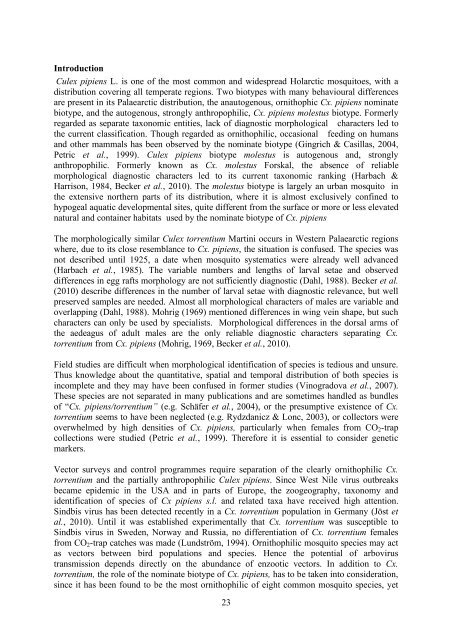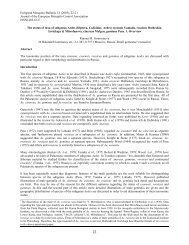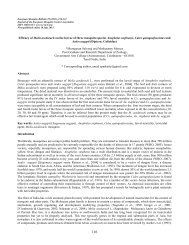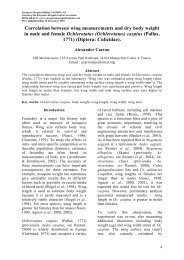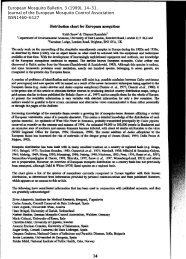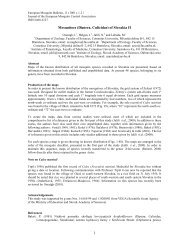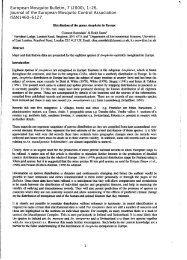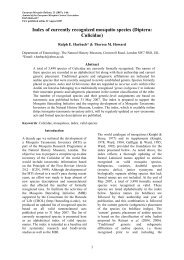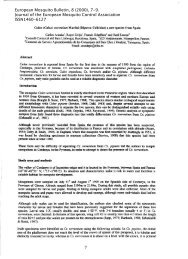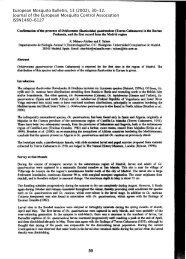22 Distribution and frequency of Culex pipiens and Culex torrentium ...
22 Distribution and frequency of Culex pipiens and Culex torrentium ...
22 Distribution and frequency of Culex pipiens and Culex torrentium ...
Create successful ePaper yourself
Turn your PDF publications into a flip-book with our unique Google optimized e-Paper software.
Introduction<strong>Culex</strong> <strong>pipiens</strong> L. is one <strong>of</strong> the most common <strong>and</strong> widespread Holarctic mosquitoes, with adistribution covering all temperate regions. Two biotypes with many behavioural differencesare present in its Palaearctic distribution, the anautogenous, ornithophic Cx. <strong>pipiens</strong> nominatebiotype, <strong>and</strong> the autogenous, strongly anthropophilic, Cx. <strong>pipiens</strong> molestus biotype. Formerlyregarded as separate taxonomic entities, lack <strong>of</strong> diagnostic morphological characters led tothe current classification. Though regarded as ornithophilic, occasional feeding on humans<strong>and</strong> other mammals has been observed by the nominate biotype (Gingrich & Casillas, 2004,Petric et al., 1999). <strong>Culex</strong> <strong>pipiens</strong> biotype molestus is autogenous <strong>and</strong>, stronglyanthropophilic. Formerly known as Cx. molestus Forskal, the absence <strong>of</strong> reliablemorphological diagnostic characters led to its current taxonomic ranking (Harbach &Harrison, 1984, Becker et al., 2010). The molestus biotype is largely an urban mosquito inthe extensive northern parts <strong>of</strong> its distribution, where it is almost exclusively confined tohypogeal aquatic developmental sites, quite different from the surface or more or less elevatednatural <strong>and</strong> container habitats used by the nominate biotype <strong>of</strong> Cx. <strong>pipiens</strong>The morphologically similar <strong>Culex</strong> <strong>torrentium</strong> Martini occurs in Western Palaearctic regionswhere, due to its close resemblance to Cx. <strong>pipiens</strong>, the situation is confused. The species wasnot described until 1925, a date when mosquito systematics were already well advanced(Harbach et al., 1985). The variable numbers <strong>and</strong> lengths <strong>of</strong> larval setae <strong>and</strong> observeddifferences in egg rafts morphology are not sufficiently diagnostic (Dahl, 1988). Becker et al.(2010) describe differences in the number <strong>of</strong> larval setae with diagnostic relevance, but wellpreserved samples are needed. Almost all morphological characters <strong>of</strong> males are variable <strong>and</strong>overlapping (Dahl, 1988). Mohrig (1969) mentioned differences in wing vein shape, but suchcharacters can only be used by specialists. Morphological differences in the dorsal arms <strong>of</strong>the aedeagus <strong>of</strong> adult males are the only reliable diagnostic characters separating Cx.<strong>torrentium</strong> from Cx. <strong>pipiens</strong> (Mohrig, 1969, Becker et al., 2010).Field studies are difficult when morphological identification <strong>of</strong> species is tedious <strong>and</strong> unsure.Thus knowledge about the quantitative, spatial <strong>and</strong> temporal distribution <strong>of</strong> both species isincomplete <strong>and</strong> they may have been confused in former studies (Vinogradova et al., 2007).These species are not separated in many publications <strong>and</strong> are sometimes h<strong>and</strong>led as bundles<strong>of</strong> “Cx. <strong>pipiens</strong>/<strong>torrentium</strong>” (e.g. Schäfer et al., 2004), or the presumptive existence <strong>of</strong> Cx.<strong>torrentium</strong> seems to have been neglected (e.g. Rydzdanicz & Lonc, 2003), or collectors wereoverwhelmed by high densities <strong>of</strong> Cx. <strong>pipiens</strong>, particularly when females from CO 2 -trapcollections were studied (Petric et al., 1999). Therefore it is essential to consider geneticmarkers.Vector surveys <strong>and</strong> control programmes require separation <strong>of</strong> the clearly ornithophilic Cx.<strong>torrentium</strong> <strong>and</strong> the partially anthropophilic <strong>Culex</strong> <strong>pipiens</strong>. Since West Nile virus outbreaksbecame epidemic in the USA <strong>and</strong> in parts <strong>of</strong> Europe, the zoogeography, taxonomy <strong>and</strong>identification <strong>of</strong> species <strong>of</strong> Cx <strong>pipiens</strong> s.l. <strong>and</strong> related taxa have received high attention.Sindbis virus has been detected recently in a Cx. <strong>torrentium</strong> population in Germany (Jöst etal., 2010). Until it was established experimentally that Cx. <strong>torrentium</strong> was susceptible toSindbis virus in Sweden, Norway <strong>and</strong> Russia, no differentiation <strong>of</strong> Cx. <strong>torrentium</strong> femalesfrom CO 2 -trap catches was made (Lundström, 1994). Ornithophilic mosquito species may actas vectors between bird populations <strong>and</strong> species. Hence the potential <strong>of</strong> arbovirustransmission depends directly on the abundance <strong>of</strong> enzootic vectors. In addition to Cx.<strong>torrentium</strong>, the role <strong>of</strong> the nominate biotype <strong>of</strong> Cx. <strong>pipiens</strong>, has to be taken into consideration,since it has been found to be the most ornithophilic <strong>of</strong> eight common mosquito species, yet23


